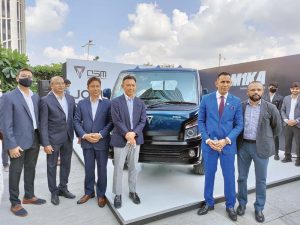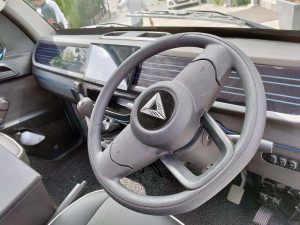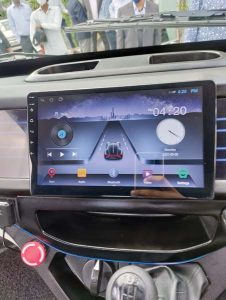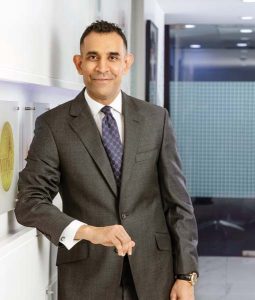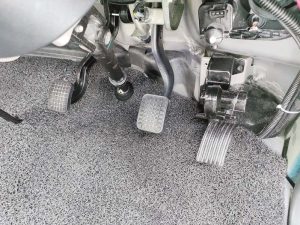Omega Seiki Mobility unveiled the M1KA ahead of its commercial rollout. Sumesh Soman gives a lowdown on the green and practical small commercial vehicle.
Omega Seiki Mobility (OSM) is the mobility arm of the Anglian Omega Network. Focussed on providing green and practical smart solutions for e-commerce, cargo and logistics companies, the company unveiled the M1KA ahead of its commercial rollout slated for the fourth quarter (Q4) of 2021. Claimed to be the first electric Small Commercial Vehicle (SCV), it is engineered to capitalise on the current SOPs and favourable market conditions, according to Uday Narang, Founder and Chairman, Omega Seiki Mobility. Speaking on the sidelines of the unveiling, Narang said, “The EV market is growing especially in the commercial vehicles segment on the back of cost-effectiveness, sustainable solutions and increasing support from the centre and the respective state governments. The current SOPs and favourable environment motivate us to expand our EV offerings for our customers.” Thrilled at the prospects of the M1KA, team OSM, added Narang, “The next-generation electric commercial vehicle will further solidify our mission to attain net-zero carbon mobility solutions.”
OSM M1KA
In a transition to four-wheeler SCVs from its three-wheeler product offerings, OSM, as per Narang is confident of succeeding in its first attempt. The M1KA is not only claimed to be green from the tailpipe emissions perspective, it is also claimed to be a practical net-zero carbon mobility solution that is customisable in keeping with the customer requirements. With bookings expected to open in Q42021, buyers can book the M1KA with a token amount of Rs.2000. Delivery of the M1KA is expected to follow suit by the second to the third quarter of 2022 (Q2-Q32022). Tight-lipped on the commercials, one expects the M1KA to launch at a ballpark price of Rs.15-16 lakh.
Judging by the looks
For a commercial vehicle, the M1KA looks quite flamboyant. The glossy dark blue shade shows off a good finish and a body paint job done well. The front apron houses trapezoidal headlamps with LED Daylight Running Lamps (DRLs). It houses projector lenses along with LED turn indicators. The windscreen scale is generous for the segment and offers a larger peripheral vision. This is expected to enhance on-road safety and offer a commanding stance to its pilot. One cannot miss the OSM chrome badging on the nose of the vehicle and the M1KA badging close to the right headlamp when viewed head-on. The M1KA badging extends to the doors five-spoke with attractive decals as well. The front bumper houses fog lamps expected to aid in poor visibility and strike a good balance between the mix of fibre and metal on the whole. Don’t miss the devil’s horn-like spikes on the cabin roof. The fibre is symmetrically extended from the front fascia to the side guards right up to the 10 ft. cargo deck rated for a payload capacity of two-tonne.

Lending to the flamboyance and upmarket appeal, the M1KA comes as a breath of fresh air with mirrors painted in a shade of the body blue. Adding to the plush appeal are the twin five-spokes. Although one needs to wait for the production spec to see if they stick on in the fully-loaded variant when commercially rolled out. They are likely to get replaced by steel wheels on the production model and take away a share of the flamboyance with it. Suspension duties are carried out by six leaves (parabolic)on the front and a seven-leaf setup at the rear of the M1KA.
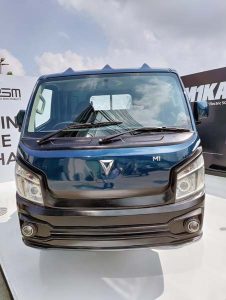
Making way for easy ingress, the doors opened to a clean dash. The seven-inch instrument cluster takes a central stance and comes loaded with Android auto and ~ 20 connected features. The feature list includes vehicle monitoring, geo-fencing, speed limiter among others to keep the vehicle and drivers in check at all times. The doors are fitted with knick-knacks like a bottle holder and a conventional roll down the window. The plush seats with cushion for added comfort and a fatigue-free ride offer convenient storage space positioned right between the pilot and the helper. My only niggle with the vehicle would be the plastic quality used inside the door and dash which has room for improvement. Once the price points are released, one can judge the inclusions and exclusions more holistically. One hopes that the production specs are not a drastic U-turn on the beta version we got our hands-on
The Driveline
At the heart of the M1KA is a 90 kWh NMC battery pack and an electric motor. The latter is mated to a five-speed manual gearbox that puts out 347 Nm of torque and a top speed of 100 kmph (without speed governor). Narang claimed the SCV can clock a 250 km range on a single charge with the vehicle capable of being fully charged in about four hours through a DC fast charging unit. Deb Mukherji, Managing Director, Omega Seiki Mobility mentioned, “With a focus on engineering and tech enabled automotive solutions catering to the future of mobility, OSM provides market-leading vehicles built on adaptable platforms, and use our own proprietary technology, providing customers with tailored e-mobility solutions at the lowest Total Cost of Ownership (TCO).” “At OSM, we are committed to providing reliable mobility solutions to our customers. Introducing the first electric SCV will further bolster our commitment to a cleaner environment. We are confident to sustain a strong foothold in the segment with M1KA and would like to thank our customers for their constant support,” he expressed. With the M1KA, OSM is known to target a customer segment that combines owner-cum-drivers and fleet owners, who seek maximum efficiency and can be a little adamant when it comes to cost-effectiveness. Deemed a milestone development, M1KA is expected to open doors for the company. t can look at more solutions for the front, middle and the last mile. The company, concluded Narang, is working on a product that could compete in the 3.5-7.5-tonne segment with products like the Tata 407 and even bring out higher variants if all goes as per plan.
The Outlier
In an Industry Talk With CV session, Uday Narang, Founder and Chairman, Omega Seiki Mobility speaks to on being the outlier and disrupting the small commercial vehicles segment.
- How did M1KA come into being and what is its positioning?
- I have been looking at the CV segment for quite some time. And my biggest concern was that 80 per cent of the time, they stay at the borders, there is an efficiency loss, the drivers and everybody involved in the journey has to wait all night for what we call the cannonball run. I felt that it was the need of the hour because that is a vehicle that is the heartbeat of intra-city transport. We felt a 250-kilometre range, and up to, two-tonne of load carrying capacity was the ideal offering for the product. I’m talking about average companies in transportation. A couple of things that could be impacted for them. Their efficiency will increase; they don’t need to work at night; the safety of drivers improves and so the overall ecosystem improves. And we felt the time was right with whatever experiences we’ve gathered on the three-wheelers and two-wheelers. And because we are a solution provider, this is the next level for us. There will be many other solutions on offer from us. We are working on being the first, middle and last-mile solutions provider and meeting the needs of the entire customer universe.
- Is M1KA a stepping stone for the company to attain newer highs?
- Every product is close to my heart. My son’s name is Mika and so this is like my baby. I’ve been involved in it right from inception with the Research and Development (R&D) team. We believe this is a very important key for us. Every product line will be run separately. This is the first step towards bigger trucks. So what we want to do is we want to take baby steps of doing an SCV, We want to do something which is almost close to the 407, and then follow it up with bigger offerings. With the fuel prices soaring, we want all companies or individuals to be able to take advantage of our new technology. Why should the people at the lower end of the game be left out?
- How robust is the charging infrastructure and ecosystem for the M1KA to succeed?
- We are going to announce very shortly an alliance with a very large, probably the largest player in this country who has access to everything. The plan is to identify corridors for the charging network. We want to build an ecosystem. We will announce under the OSM grid many alliances on building charging stations especially those corridors where we have a presence of 10-15 vehicles.
- What is your take on government intervention pertaining to e-mobility?
- Our strategy is to be an early mover. We are going to force everyone to move towards electrification because it makes sense. It makes sense in terms of cost, and it makes sense in terms of the environment. The government subsidies and the government involvement, the PLI schemes are fantastic. And I think the central government and the state governments are very proactive. The schemes are a helping hand but we cannot be dependent. My business model is not dependent on the government. The idea is to be able to develop products that the customers buy, because it saves them costs and helps better the environment.
- How do you plan on hand holding customers, from purchase to the after sales journey?
- We have a team called ‘Team 360’. It is involved in service and technology. But the key part is, we’ve got to get all of our touch points ready. We’ve got, in all, 40 of them and aim to expand up to 120. By the end of the year, we plan to set up training sessions, where drivers can come and learn how to drive the vehicles. How to be efficient, how to charge and or fix the vehicles. Our teams will be working with them so that they are not just stuck in one place. Hand holding customers is part of building the ecosystem for us.
- How are you holding your supply chain together in these volatile times?
- We have been in the automotive business for over 52 years and we’ve seen ups and downs. But what we have always been successful with is planning for the longer term. We will work with the chip manufacturers and the battery manufacturers. There might be some dips, but I am of the firm belief that after the storm comes the sunshine. India is back and open, and we’ve learnt to live with the challenges.
- What is the future roadmap for OSM?
- We are looking at larger vehicles. We feel that this country should forget ICE, and go electric. I’m also saying the future might be hydrogen, but I believe it will take some time. So our view is let’s not just think on a short commercial basis, think big, build a platform, build a system, and build the charging network. We must educate the customers, give them confidence, give them the warranty and build the ecosystem as part of a strategy for the next decade, maybe more.



